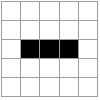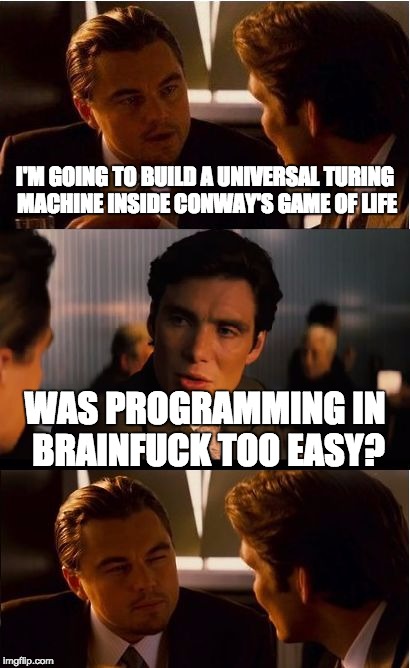Exploring Conway's Game of Life
Three computers held sway over my brothers and I during my childhood: the Commodore 64 and its games, spread across dozens of 5 ¼ inch floppy disks; the IBM XT and the short stories I wrote in WordPerfect; and the king of them all – the Intel 386 running DOS 5. Aside from newer games with insanely cool graphics1, the 386 brought QBasic and a C compiler into our lives. From that point on, instead of Ultima IV, I watched fractals, cellular automata, and homegrown computer games develop — all from my perch behind the computer chair, watching over my brothers' shoulders2.
Every few years, something reminds me of cellular automata and my fascination starts all over again3. A few weeks ago, reading about common patterns and problems in Go reminded me of structures that show up in John Conway’s Game of Life — especially the “Crane In the Nest”:

The similarity may not be a coincidence: according to Wikipedia, some of the early Game of Life explorations were conducted using just graph paper and Go boards.
A cellular automaton is a simple simulated universe, where time moves forward in discrete steps and space is a lattice of finite-state machines4. In two state automaton (like Conway’s Game of Life), each cell in the lattice can be alive or dead. The state of a cell at the next moment is determined by the states of its neighbors now. The rules for the Game of Life are:
- A dead cell comes to life if three neighbors were alive.
- A live cell survives if either two or three neighbors were alive.
- A live cell dies if it has fewer than two live neighbors or greater than three live neighbors.
Some structures are stable and static:
Beehive Block Boat


Other structures are stable, but oscillate:
Beacon Blinker Toad


And then there’s the glider, a stable pattern that moves across the lattice.
The three rules of the Game of Life are enough to send this little buddy exploring!

Forty-six years after its introduction, Conway’s Game of Life still has fans. ConwayLife.com and its associated wiki catalogue newly discovered patterns and variations. There are other shapes like the glider — the “spaceships” — which move across the field. There are glider guns: oscillating structures which periodically emit new gliders. As of July 8th, there are over eight hundred patterns in the wiki and the most recent pattern was discovered just this week! Among the patterns, there’s even a universal Turing machine5. With enough patience, you could simulate Conway’s Game of Life inside Conway’s Game of Life by encoding it in the initial state of the universal Turing machine pattern. Once you’re at it, why not encode the Game of Life in that simulation?

The beautiful thing about all these patterns is that they are consequences of the rules, but they are not in the rules. Inertia isn’t in the rules, yet something like inertia seems to drive the glider inexorably in the direction that it faces. The more complex patterns — the so-called “engineered” patterns — have to be hand-crafted, but the simplest arise from most initial conditions. Watch how blocks, oscillators, and gliders all show up when I seed Life with a bunch of scribbles6:
Think about the origins of life, in all its complexity. How did we get here, from a nuclear oven shining on a wet rock hurtling through space? The Game of Life on its own isn’t quite rich enough for RNA and one-celled organisms to emerge from a prebiotic soup, but the comparison is tempting — it is in the name, after all. Manuel DeLanda has a great explanation of the combinatoric inevitability of these structures in Philosophy and Simulation: The Emergence of Synthetic Reason:
Blocks, blinkers, and gliders are referred to as “natural” patterns because when one starts a Life session with a random population of live and dead cells these three patterns (and other simple ones) emerge spontaneously. This spontaneity is explained both by the fact that the patterns are small — patterns made out of a few live cells have a higher probability of occurring than large ones — and by the fact that they can arise following several sequences of predecessor patterns: the more numerous the sequences converging on a pattern the higher likelihood that one of them will occur by chance.
The Game of Life is the superstar among cellular automata, but even the simplest cellular automata can generate strange and unexpected behavior. Elementary cellular automata — which are similar to Conway’s Game of Life, but one-dimensional — make for a good toy language-learning problem.
-
Two-hundred and fifty-six colors! ↩︎
-
To be honest, I was mostly waiting for my turn with the PC so I could play Commander Keen and Secret Agent… I didn’t really get into math and programming until years later. ↩︎
-
Likewise, at least once a year I remember that colossal squid are a thing and that the bottom of the ocean is a vast and mysterious place. There’s some kind of Wikipedia page playlist on repeat in my life… ↩︎
-
A finite-state machine is a system with a finite number of well-defined states, which can transition between them only according to particular rules. ↩︎
-
A universal Turing machine is effectively a programmable computer. Any computation that can be performed on the device you’re using to read this could also be performed in any other Universal Turing Machine – although much slower and with a lot of tedious work to read the results. ↩︎
-
I recorded this using Golly, a great open-source Game of Life implementation. ↩︎